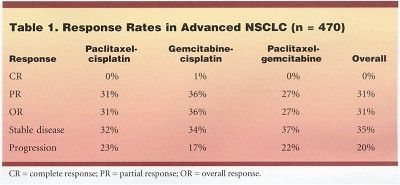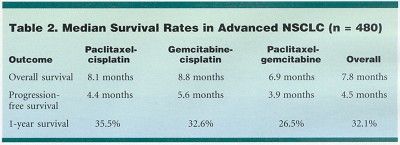Platinum-Based Regimens Are Favored in Advanced NSCLC
SAN FRANCISCO-A randomized phase III trial of three chemotherapy regimens in advanced non-small-cell lung cancer (NSCLC) confirmed platinum-containing combinations as the standard treatment, according to a presentation at the 37th Annual Meeting of the American Society of Clinical Oncology (ASCO abstract 1228). The EORTC trial (08975) compared cisplatin (Platinol) and paclitaxel (Taxol) to gemcitabine (Gemzar) with either cisplatin or paclitaxel.
SAN FRANCISCOA randomized phase III trial of three chemotherapy regimens in advanced non-small-cell lung cancer (NSCLC) confirmed platinum-containing combinations as the standard treatment, according to a presentation at the 37th Annual Meeting of the American Society of Clinical Oncology (ASCO abstract 1228). The EORTC trial (08975) compared cisplatin (Platinol) and paclitaxel (Taxol) to gemcitabine (Gemzar) with either cisplatin or paclitaxel.
Jan P. Van Meerbeeck, MD, of the EORTC-Lung Cancer Group, Brussels, said that clinical trials have established that combination chemotherapy improves survival in advanced NSCLC, especially platinum-based therapies.
While paclitaxel/cisplatin is a possible standard combination, other platinum-based combinations are in use, and attractive non-platinum-based combinations have been developed. In a recent trial, Dr. Van Meerbeeck noted, the average response rate for a paclitaxel/gemcitabine combination was 33% with acceptable toxicity.
The multinational EORTC trial was launched to answer which is the better platinum-based combination and whether cisplatin is really necessary in lung cancer, Dr. Van Meerbeeck said.
Patients (n = 480) were randomized to 3-week regimens of paclitaxel/cisplatin (the reference arm), gemcitabine/cisplatin, or paclitaxel/gemcitabine. In all regimens, paclitaxel was given at 175 mg/m² over 3 hours on day 1; cisplatin at 80 mg/m² on day 1; and gemcitabine at 1,250 mg/m² on days 1 and 8.
Included patients had stage IIIB (malignant pleural effusion and/or supraclavicular nodes) or IV disease with one or more measurable target lesions, and performance status 0 to 2. Prior neoadjuvant chemotherapy (more than than 1 year before enrollment) was allowed.
Among 470 evaluable patients, there was one complete response (in the gemcitabine/cisplatin arm), and no significant differences between arms for partial or overall response rates (Table 1).

Among hematologic toxicities, grade 3-4 neutropenia occurred in a similar percentage of patients in the three treatment arms (33% for paclitaxel/cisplatin, 43% for gemcitabine/cisplatin, and 30% for paclitaxel/gemcitabine). Grade 3-4 anemia was reported in 3%, 11%, and 4% of patients in the three arms, respectively.
Grade 3-4 thrombocytopenia occurred significantly more often in the gemcitabine/cisplatin arm than in the reference arm (1% for paclitaxel/cisplatin, 36% for gemcitabine/cisplatin, 6% for paclitaxel/gemcitabine). "The increased thrombocytopenia in the gemcitabine/cisplatin arm, however, did not result in higher rates of neutropenic fever, bleeding, or toxic deaths," Dr. Van Meerbeeck stated. The incidence of nonhematologic toxicities was low in all treatment arms.
Survival Rates
Median survival overall was 7.8 months (see Table 2). Differences were nonsignificant, but with a trend (
P
= .09) favoring the reference arm against the nonplatinum paclitaxel/gemcitabine combination. That trend (
P
= .08) was also found in median progression-free survival (overall 4.5 months). Survival at 1-year was 32.1% overall.

A multivariate analysis of possible factors affecting survival found only performance status of 2 vs 0-1 to be significant (P < .0001). In multivariate analysis, results showed a borderline negative (P = .06) treatment effect for the nonplatinum combination vs the reference arm (6.9 months vs 8.1 months).
"This brings me to the following conclusion: Both experimental arms failed to show superiority over the control arm, with a nonsignificant trend toward lower efficacy in the noncisplatin arm," Dr. Van Meerbeeck said, noting further that patients in the gemcitabine/cisplatin arm experienced more hematologic toxicities but without increased clinical complications. Future follow-up on quality of life, he added, may complement the data.
Responding to an audience question regarding the implications for future studies, Dr. Van Meerbeeck replied that the EORTC would be "sticking with platinum-containing regimens."